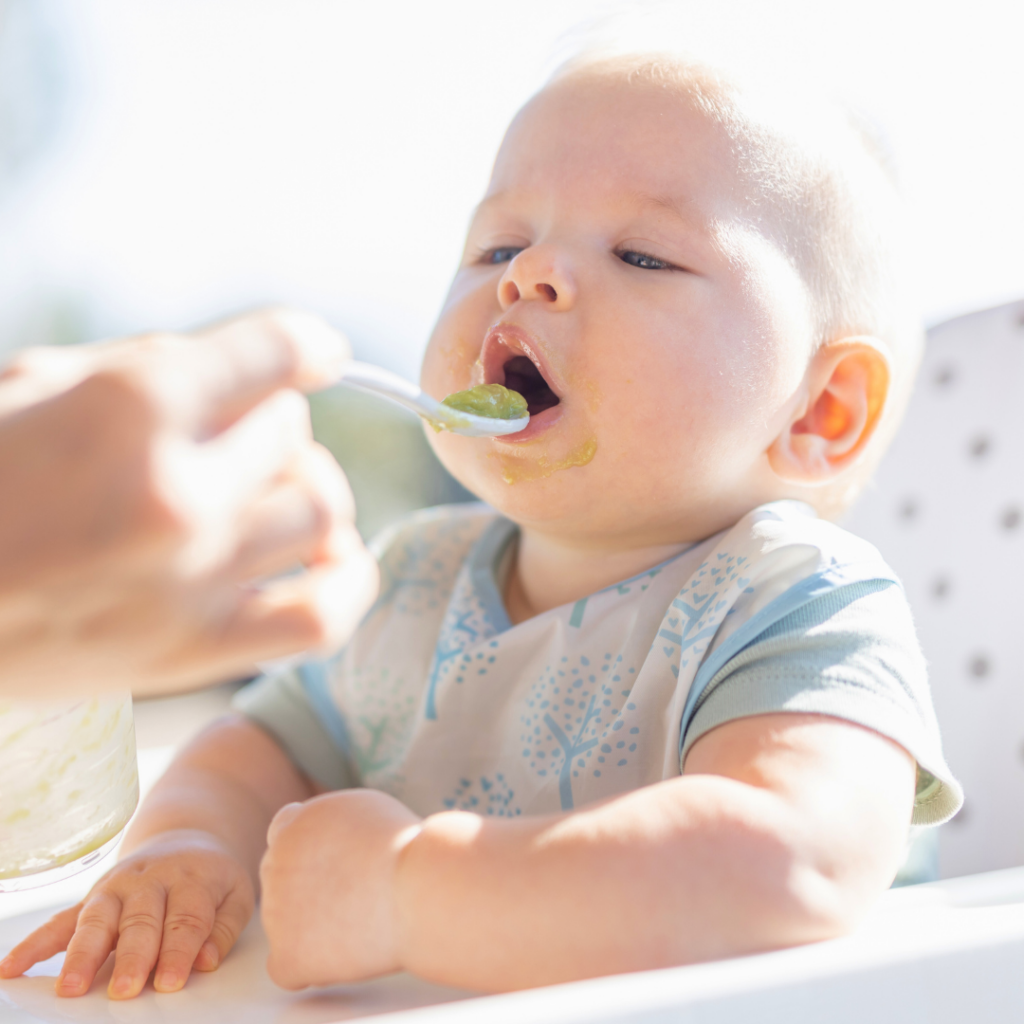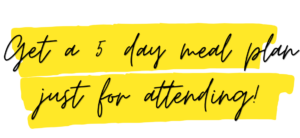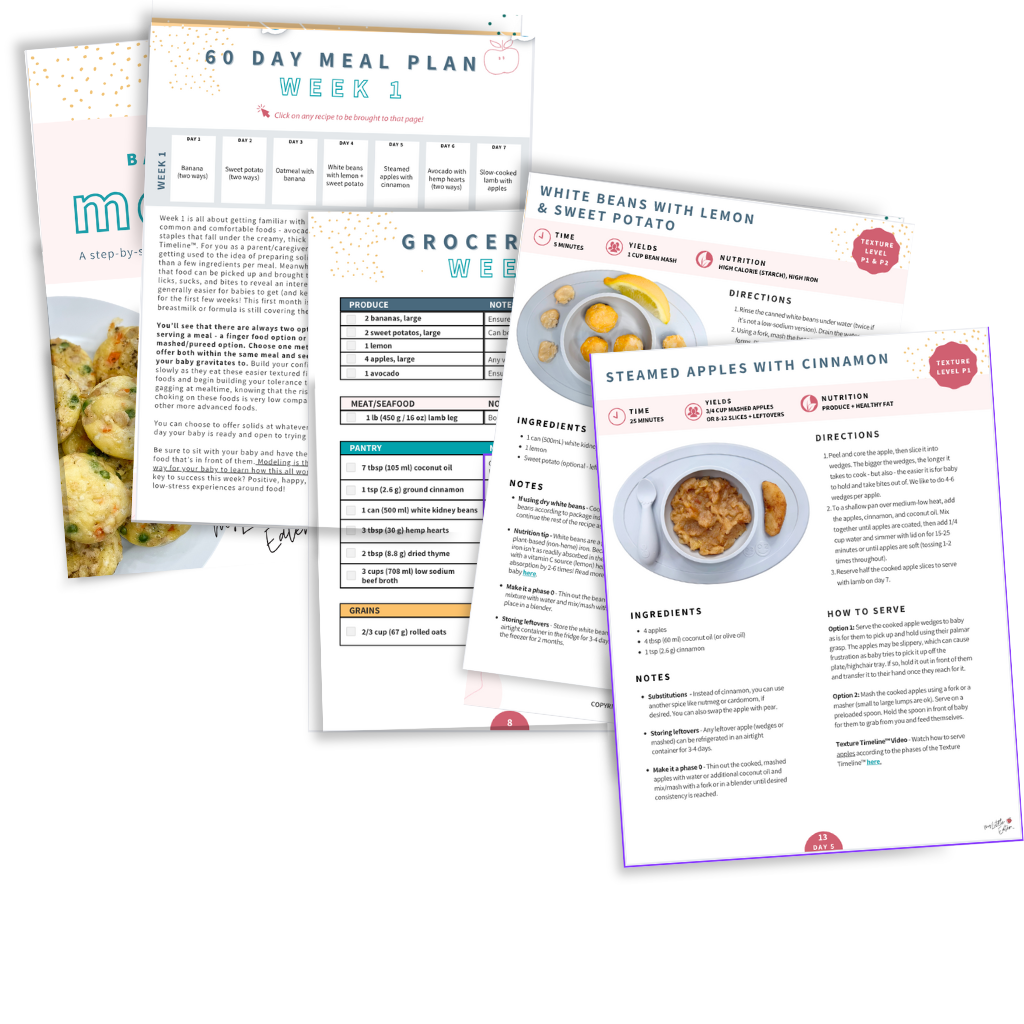This post may contain affiliate links, please view our disclosure policy for more details.
If you’re a first-time parent, you might be wondering, “When can my baby start drinking water?” – and – “How much water does my baby need?”.
With all the mixed messages in the parenting world, it can feel a bit overwhelming to find trustworthy advice. The fear of giving too much or too little water can really weigh on your mind. But guess what? You’re not alone, and we’re here to help you navigate this topic with ease!
Let’s dive in and get you all the answers you need for your little one. Whether you’re dealing with a hot summer day or just wondering about daily hydration, we’ve got you covered.
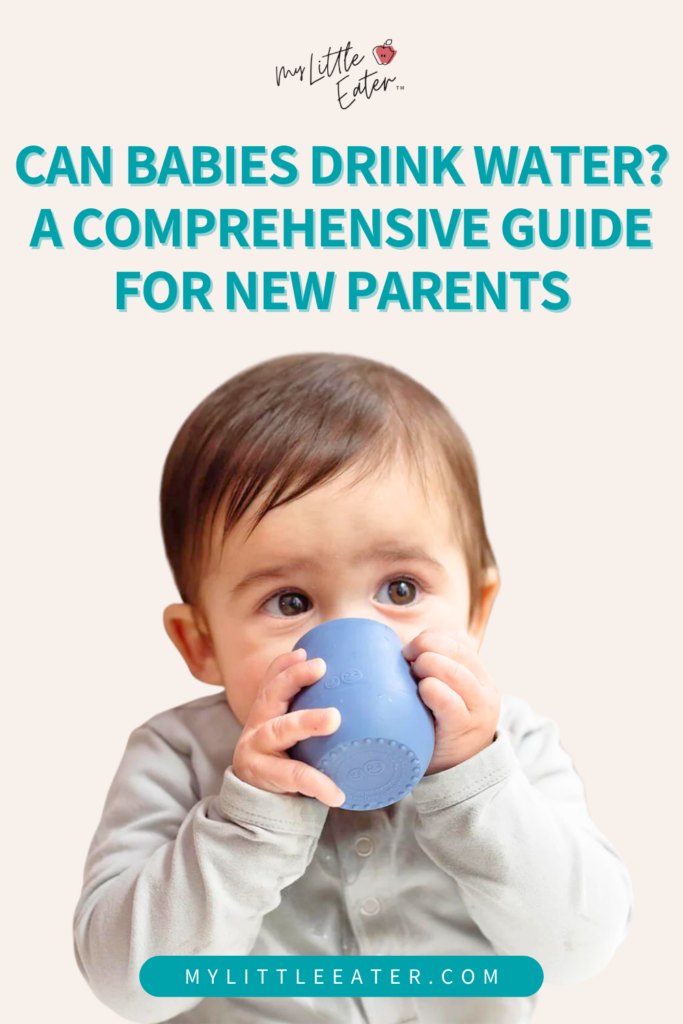
Table of Contents
When can babies drink water?
Generally, babies can start drinking small amounts of water around the time they start solids, which is typically around 6 months of age (1).
Before 6 months of age, breast milk or infant formula provides all the hydration and all the nutrients your baby needs (2). So, for almost all babies, there’s really no need for water before that point.
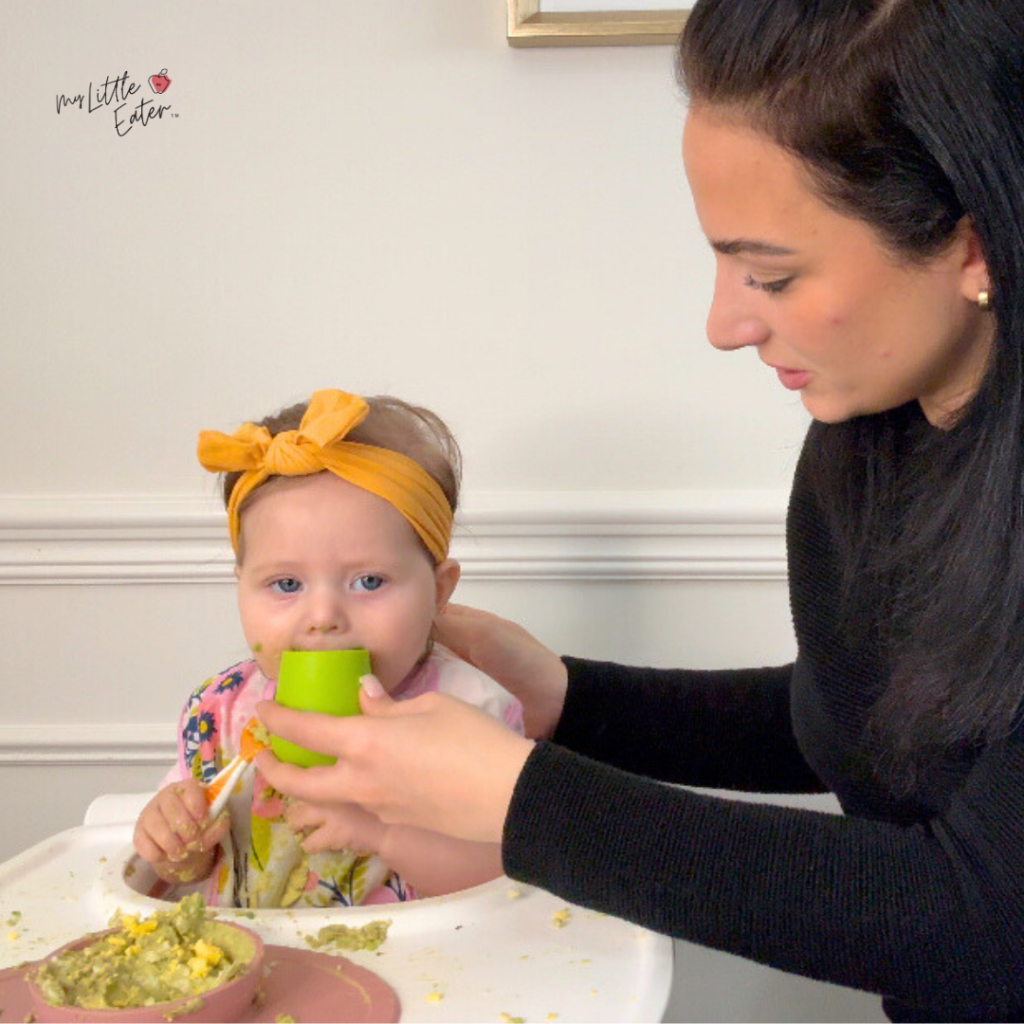
Letting your baby drink water before 6 months of age can be problematic because it can replace nutrient-rich breast milk or infant formula, which your baby needs for optimal growth and development (2).
Did you know?
Did you know?
Human milk (breast milk) contains more than 85% water!
The rest is made up of macronutrients like proteins, carbohydrates, and fats, as well as essential vitamins and minerals (2).
How much water should babies drink?
Now that we know when babies can start drinking water, let’s dive into how much water is recommended daily!
Before 12 months of age, babies really don’t need to drink a lot of water. Think of water as a supplement to their breast milk or formula, not a replacement.
The table below shows the recommended amount of water on a daily basis for babies and toddlers 0-4 years of age (1).
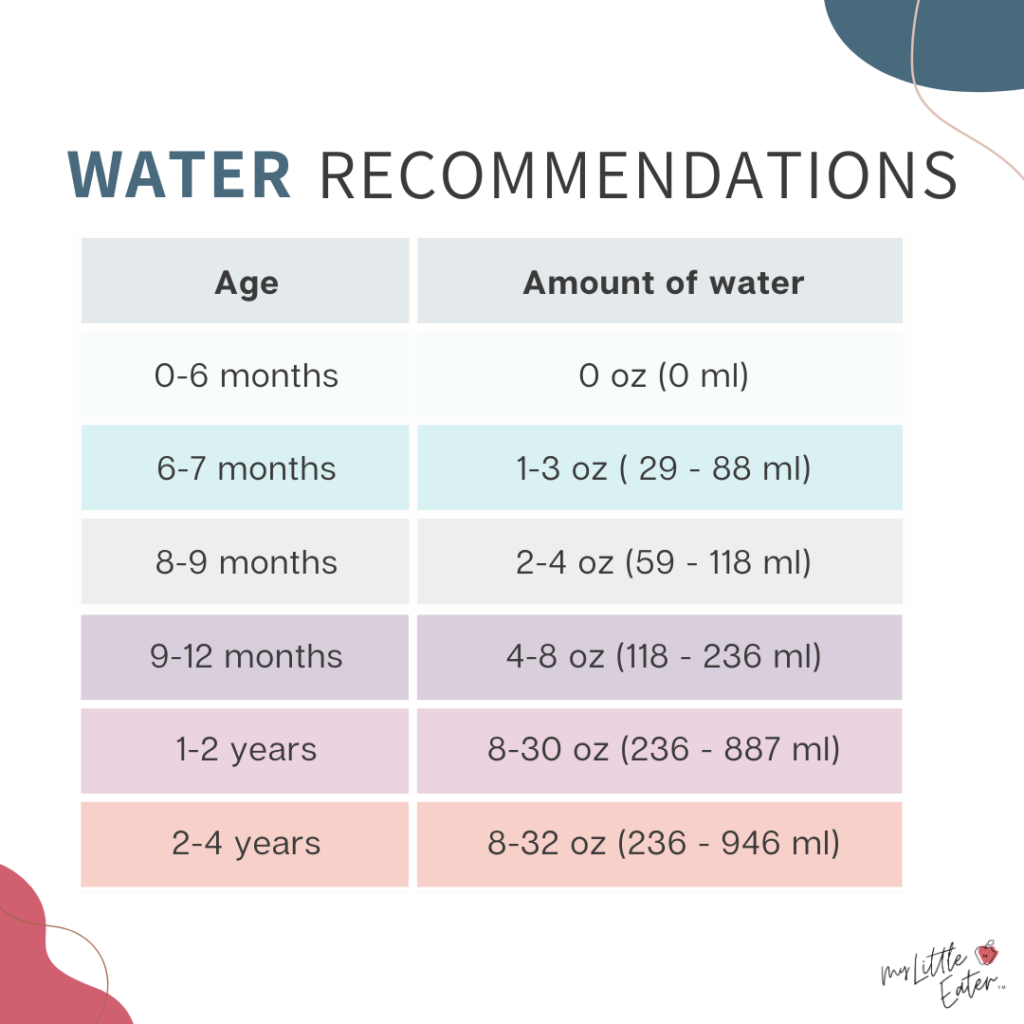
Babies 6-12 months of age can have up to the amounts indicated in the table above. However, if they need more than this to keep their hydration needs met – you can achieve that with breast milk or formula until they reach 12 months of age.
After 12 months, you need to switch things up. At that point, you want to offer more hydration through water and hydrating foods, with only a limited amount coming from milk. This is because toddlers can easily fill up on milk, leaving less room in their tiny tummies for solid foods.
We don’t want to offer any more than a maximum of 16 oz of milk per day past 12 months of age.
How frequently should you offer your baby water?
At around 6 months of age when your baby starts solids, you can offer a few sips of water with each meal. At this age, your baby will only be having one or two solid food meals a day, but as mentioned above – babies at this age don’t need water for hydration.
The main reason to offer your baby water at this age is to get them used to it, allow them to practice with an open cup, and help wash down any solids that may be “stuck” in their mouth after a meal.
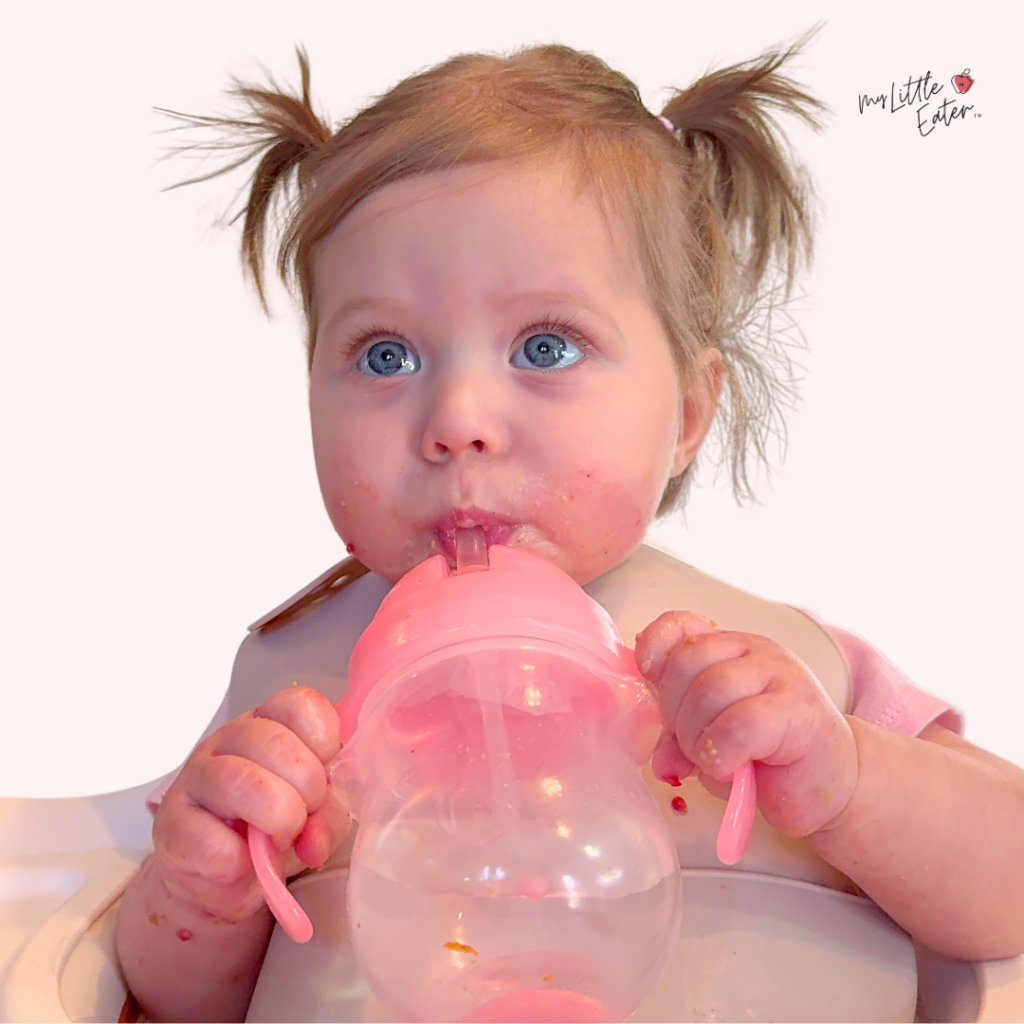
Once your baby reaches the 12-month mark, you can continue to offer water with all meals. Additionally, you’ll want to offer your baby water regularly throughout the day. We recommend getting an insulated water bottle for your toddler if possible, as this will keep water cold and fresh all day.
To keep them practicing with both open cups and straw cups, we suggest offering water in an open cup at meals when they’re seated and keeping a straw cup available to drink from in-between meals. Straw cups are less likely to spill, plus, if you get one with a closable lid you can toss it in the diaper bag when you’re heading out of the house.
You can check out our recommended water bottles below!
Adjusting water and breast milk or infant formula intake on hot days
Naturally, in hot weather, you may feel the need to offer your baby water out of concern that they’ll become dehydrated. However, since water has no calories and increases the feeling of fullness in infants, it can lead to less breast milk or formula being consumed (2). In turn, this leads to insufficient calorie intake (2).
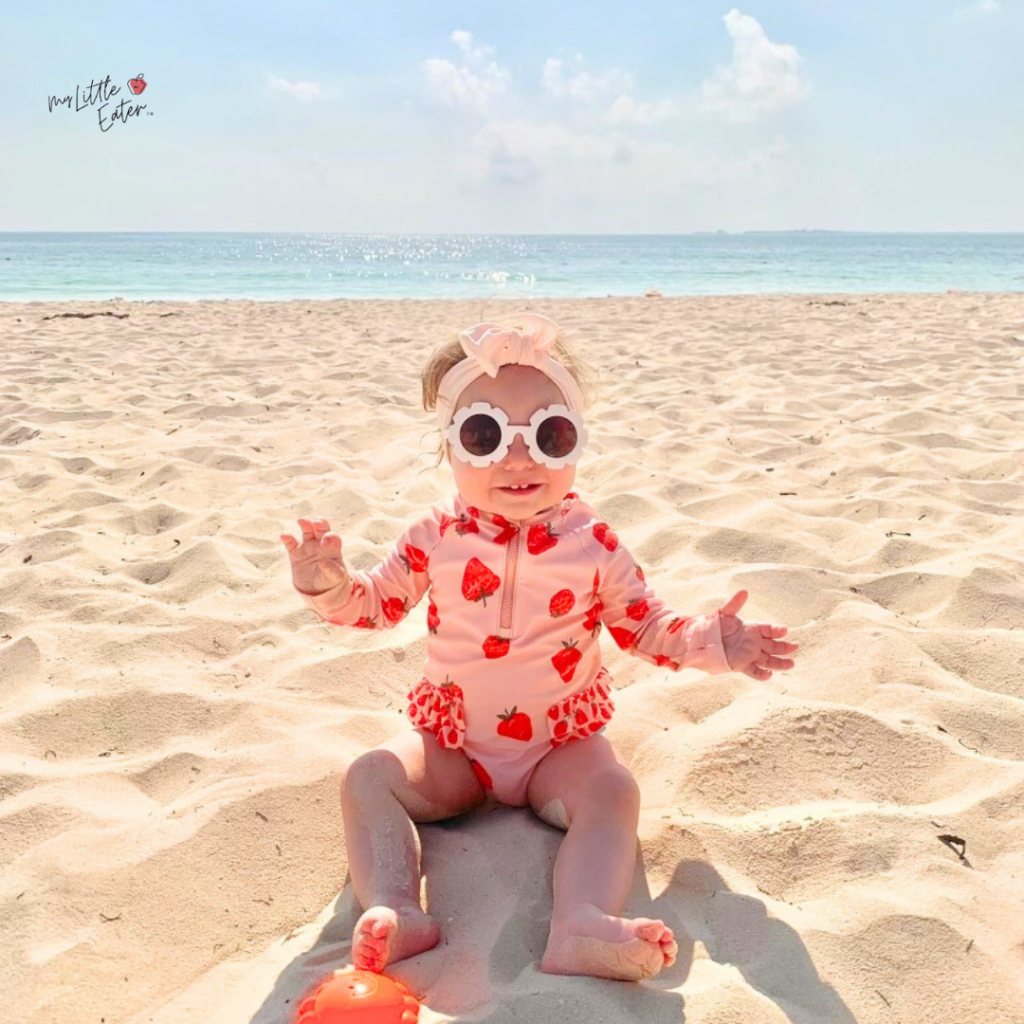
Babies under 12 months of age rely on breast milk or formula as their main source of nutrition – but it’s also their main source of hydration. That means that when it’s hot and they need to be taking in more fluids, you want to focus on offering more frequent milk feeds – not more frequent sips of water!
Keep in mind that an increased number of milk feedings may lead to your baby eating less solids than usual – but that’s ok! Pay attention to your baby’s cues – if they need to drink more to stay hydrated, offer more milk. If they’re not interested in solids much that day, let it be, and don’t force it. They’ll likely be back to eating their usual amount of solids the very next day.
Is it possible for babies to have too much water?
Yes, babies can drink too much water and that can put them at risk for what we call water intoxication (3).
Water intoxication occurs when the body takes in more water than it gets rid of, causing sodium and electrolyte levels in the body to become diluted (3, 4). This can lead to disruptions of the kidney’s normal functioning, resulting in digestive problems, behavior changes, brain damage, seizures, coma, and even death (3, 4).
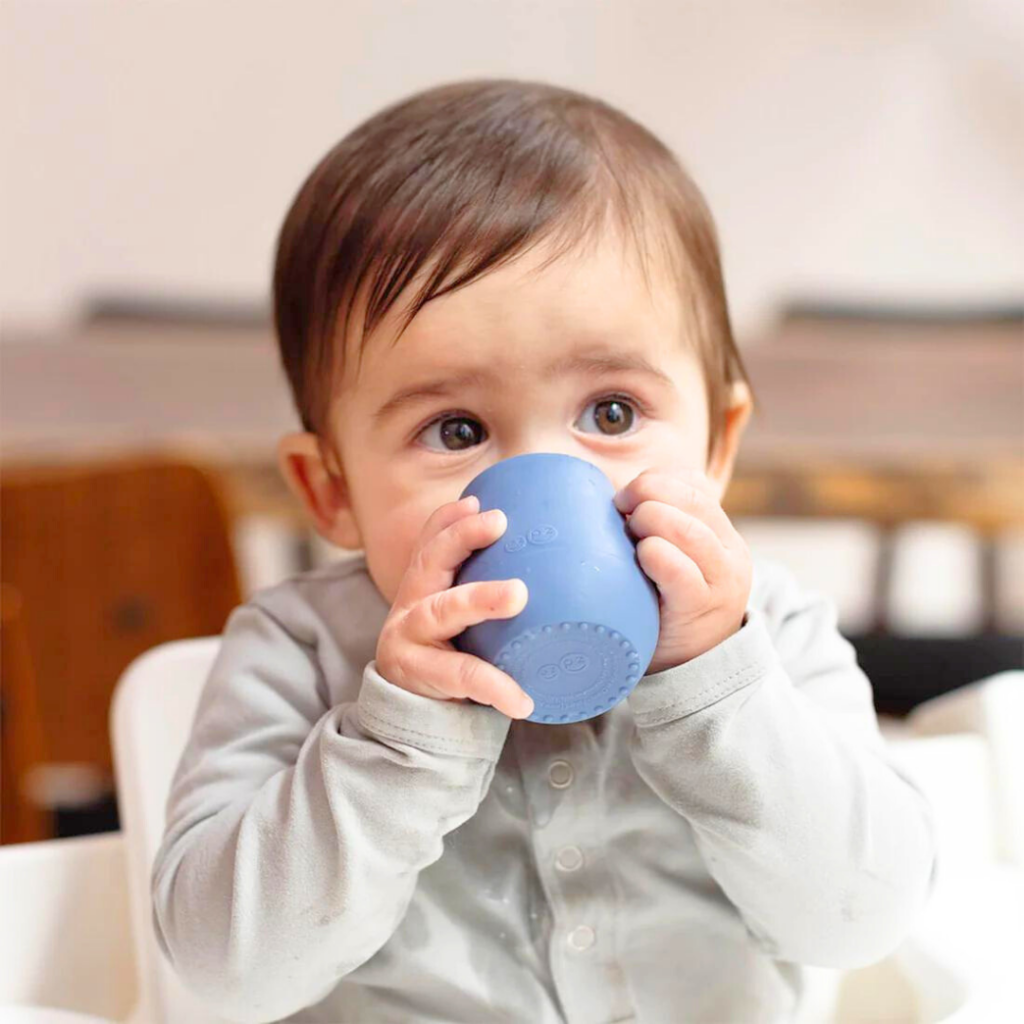
The CDC has declared that babies are at a greater risk of water intoxication during the first month of life when their kidneys’ filtering system is too immature to get rid of fluids as rapidly as older infants do (3).
This further solidifies the recommendation of waiting until 6 months of age to start offering your baby small amounts of water because their kidneys will be a bit more developed and better able to handle even those few ounces.
Symptoms of overhydration may include (3):
- Blurred vision
- Muscle cramps and twitching
- Paralysis on one side of the body
- Poor coordination
- Nausea and vomiting
- Rapid breathing
- Weakness
As you can see, these symptoms are not to be taken lightly. So although water is a healthy beverage option, there is a limit. And for babies under 12 months, it’s a lot easier to reach that limit unintentionally.
My Little Eater
Recommendation
Recommendation
Don’t panic or overthink it! If you follow the recommendations outlined in the table above for how much water a baby can safely have on a daily basis, your baby will be fine.
Because it’s so important that you follow these guidelines to avoid the possibility of water intoxication, we recommend offering sips of water using a cup that allows you to easily track water measurements. This could mean using a cup that holds only a specific amount, or a cup with clear measurements along the side. Keep reading for our top recommendations!
How do I know if my baby is dehydrated?
For most babies, 4-6 wet diapers in a 24-hour period indicate that they are well hydrated.
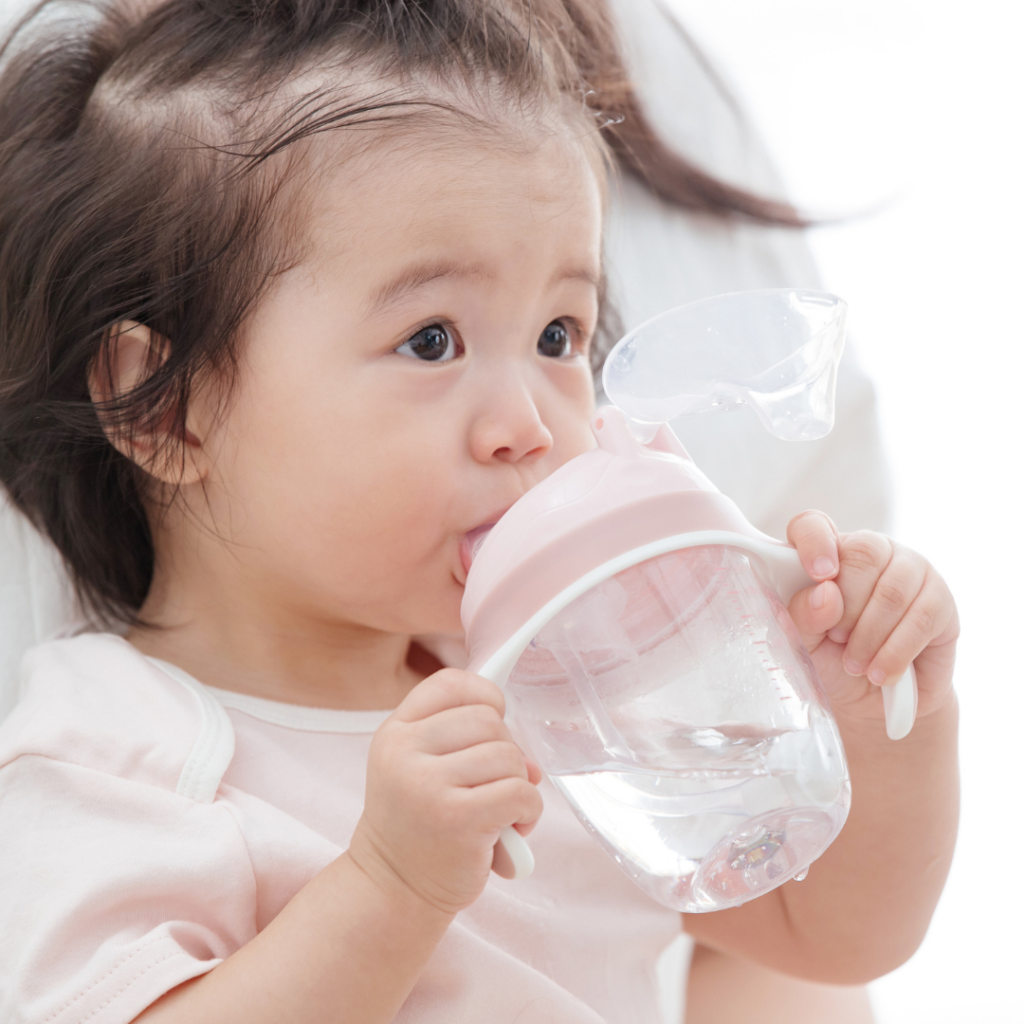
If you’re concerned your baby may be dehydrated, watch for the following symptoms to be sure (5):
- Very fussy and/or sleepy
- Urinating less frequently and/or dark urine color
- Parched, dry mouth
- Fewer tears when crying
- Sunken soft spot on top of head (for infants or young toddlers)
- Sunken eyes
If your baby is showing signs of dehydration, contact your baby’s healthcare provider right away or take them to the emergency room.
Choosing water for your baby
Safety and cleanliness are top priorities when it comes to offering your baby water. You may have even seen special “nursery” water in the baby section for mixing formula bottles. It’s only natural that would make you wonder if your baby has to drink “special” filtered water, or if regular tap water is fine.
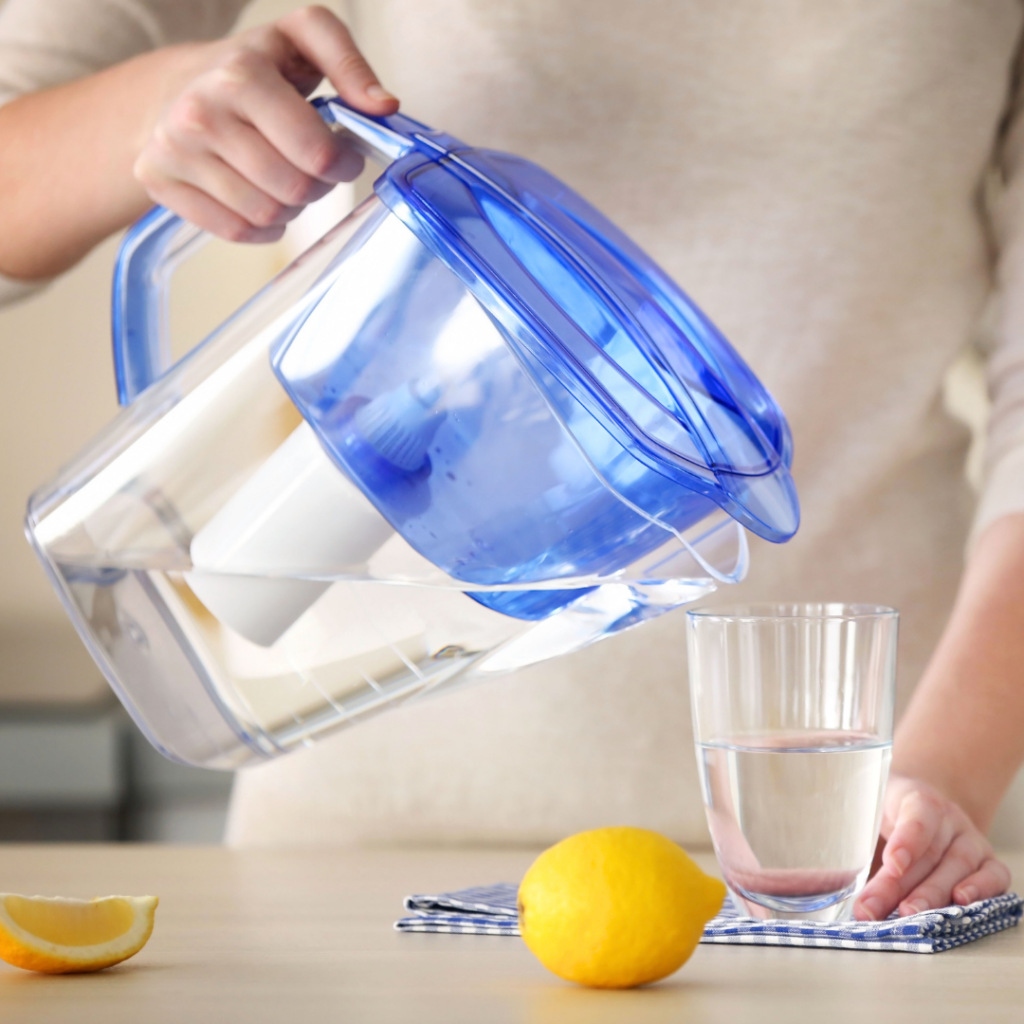
Most tap water in developed countries is safe for babies, children, and adults (6). If you want to provide an extra layer of safety, you can offer your baby filtered water but you do not have to buy special water just for babies. You can also choose to boil tap water and offer your baby the cooled, boiled water to drink as a precaution.
If you have concerns about the water quality in your area, or if your home water comes from a well, consult with your doctor or pediatrician for personalized advice.
Best water cups for babies & toddlers
We recommend offering water in an open cup or a straw cup to help your baby develop essential cup-drinking skills (skip the sippy cup completely!). Here are some of our top recommendations for open cups and straw cups for babies and toddlers!
EZPZ Tiny Cup
When you first start teaching your baby how to drink from an open cup, you can really choose any cup that’s small in size, soft, and easy for your baby to hold. We have a preference for the EZPZ tiny cup because it hits all of these marks without being overpriced!
It’s made of food-grade silicone, is SO tiny so baby can wrap their hands around it easily, and it’s available in super cute colors!
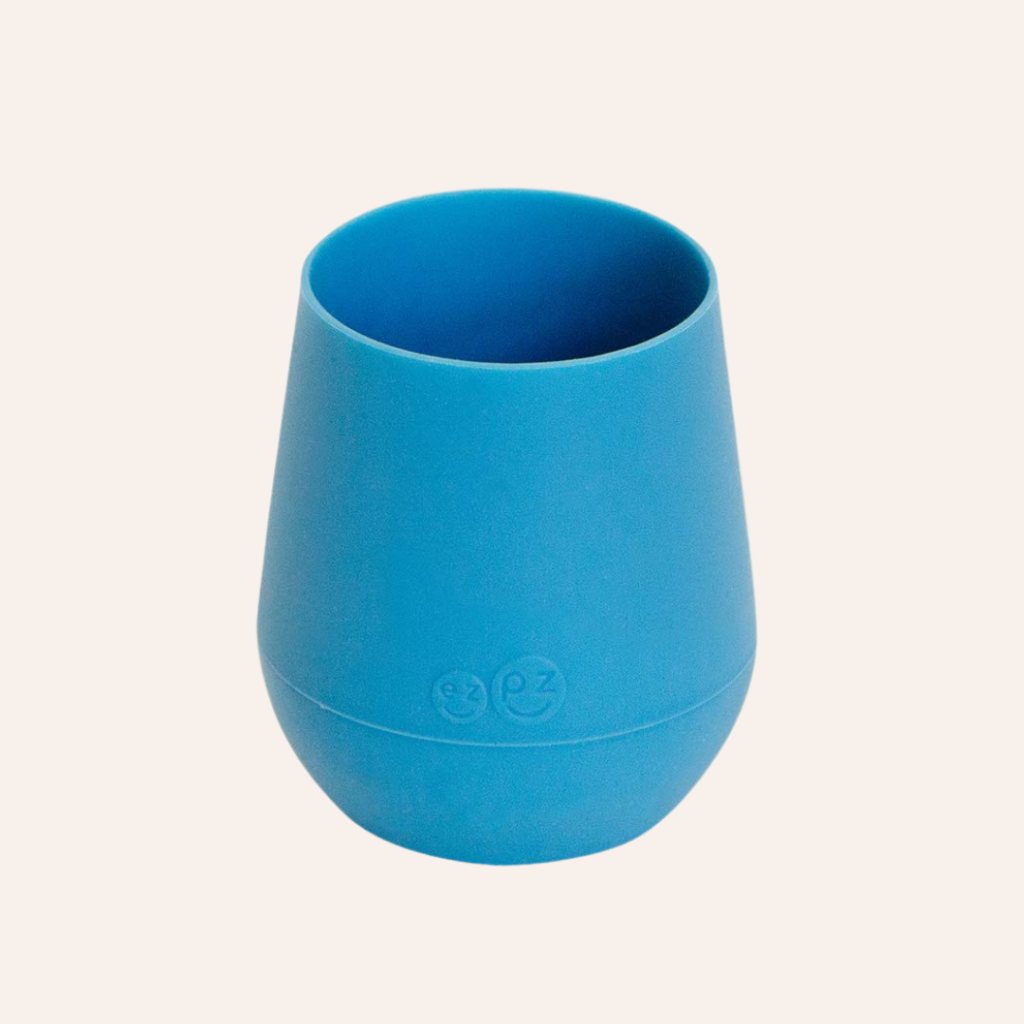
Dr. Brown's Milestones
baby's first straw cup
This straw cup has a silicone-weighted straw so your baby can drink no matter which way it tips. The handles make it easy for babies to hold on their own and are removable for when baby’s skills improve.
It’s spill-proof with a flip-top lid so it makes the perfect cup for on-the-go! Plus, it has measurements along the back so you can easily track how much water you’re offering your baby.
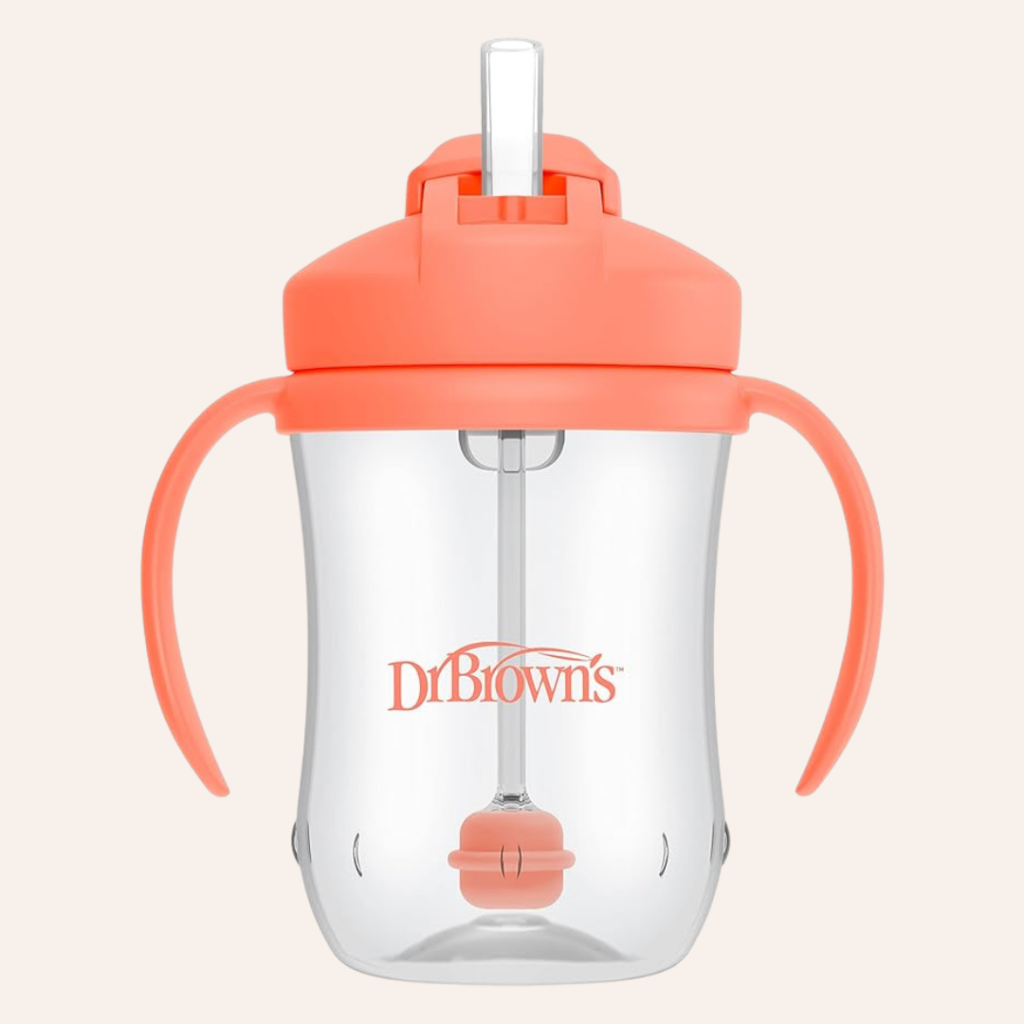
MUNCHKIN ANY ANGLE CLICK LOCK
WEIGHTED STRAW CUP
The munchkin straw cup has handles to make it easy for your baby to hold, a flip-top lid for keeping the straw covered, and a weighted straw that allows your baby to hold the cup at any angle.
The straw will need activating. Remove the lid from the cup and pull the straw and instruction manual out. Inside the top of the straw, look for a valve with an S-shaped seal and remove the seal.
This cup does not have measurements on it to keep track of how much water is being offered, and it holds 7oz., so be careful not to fill it too much or allow your baby to drink all of it.
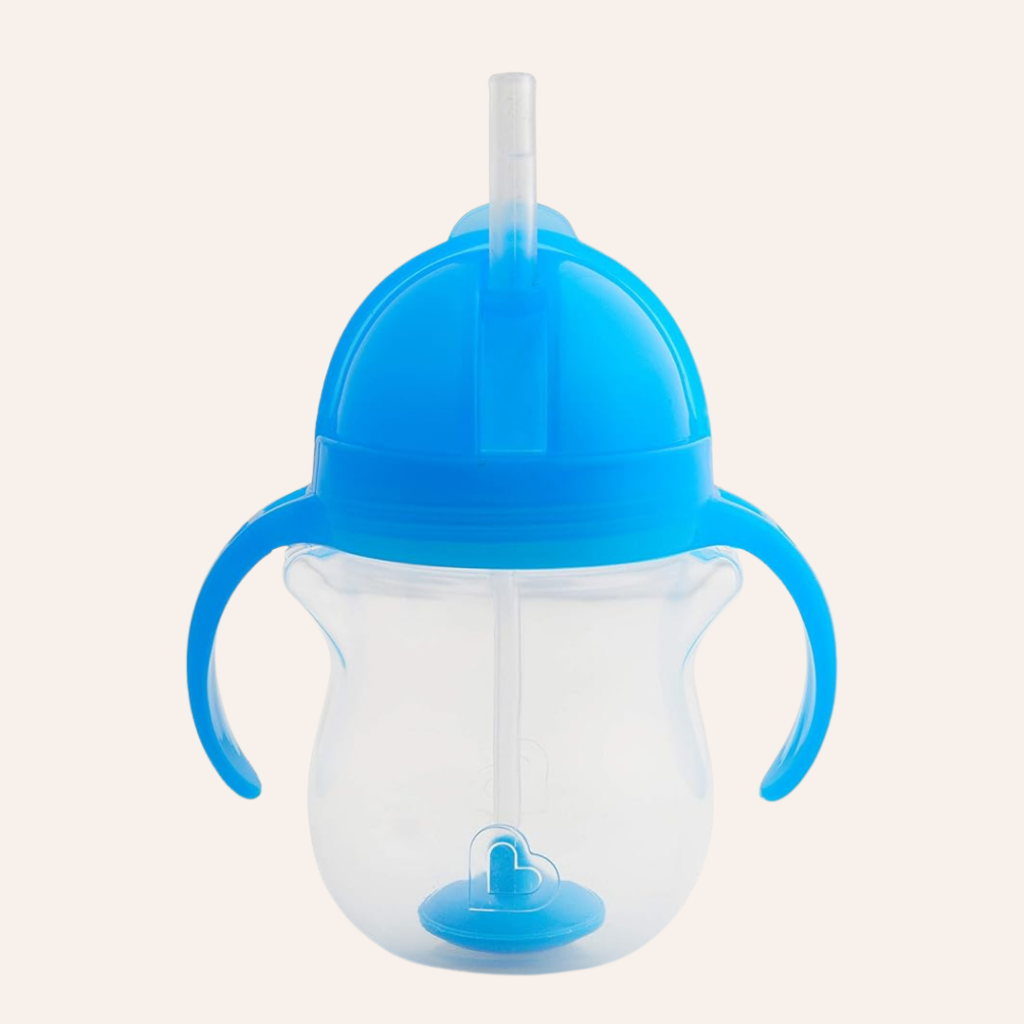
ZAK! KELSO LEAKPROOF STRAW TUMBLERS
This is a great straw cup for when your baby transitions off the bottle at around 12 months of age! It’s durable and made with BPA-free plastic, has a built-in valve to prevent leaks, a detachable spout for easy cleaning, and is top-rack dishwasher safe.
It comes in so many fun designs and colors, you’re little one will love drinking out of this cup!
Because of its larger size, be sure to avoid this cup until after 12 months when your baby can consume larger amounts of water without as much risk.
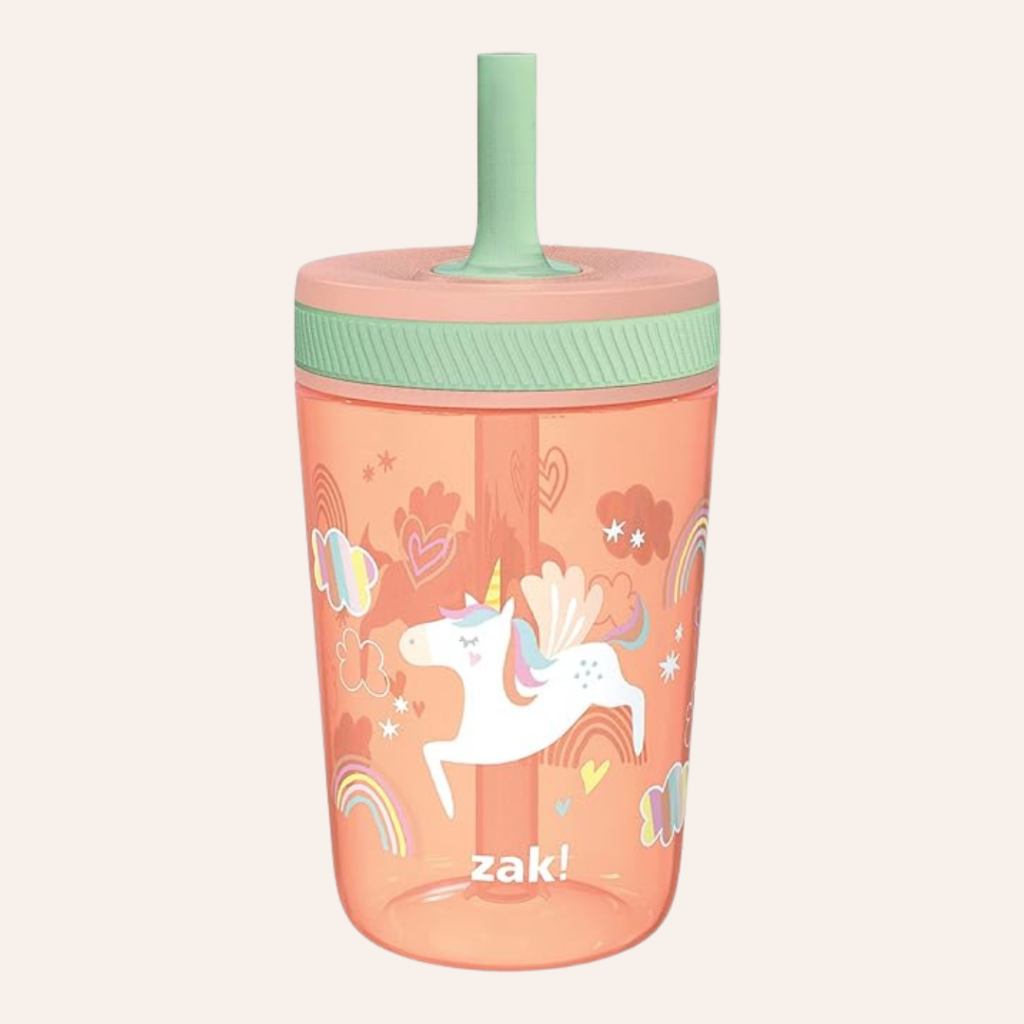
THERMOS FUNTAINER WATER BOTTLE
These water bottles are great for older toddlers when you’re on the go!
They’re made from stainless steel (super durable for a toddler who drops almost everything) and can keep drinks cold for up to 12 hours. You can purchase replacement straws as well, so these bottles will last you a long time!
They have a ton of options with fun characters to choose from, which your little one will love. We recommend these as a great option for daycare for your toddler over 12-18 months old (they’re too large for babies to hold before then). The lid will keep the straw from getting dirty while they play, plus it will keep their water cool all day, and they can carry it around with them using the handle.
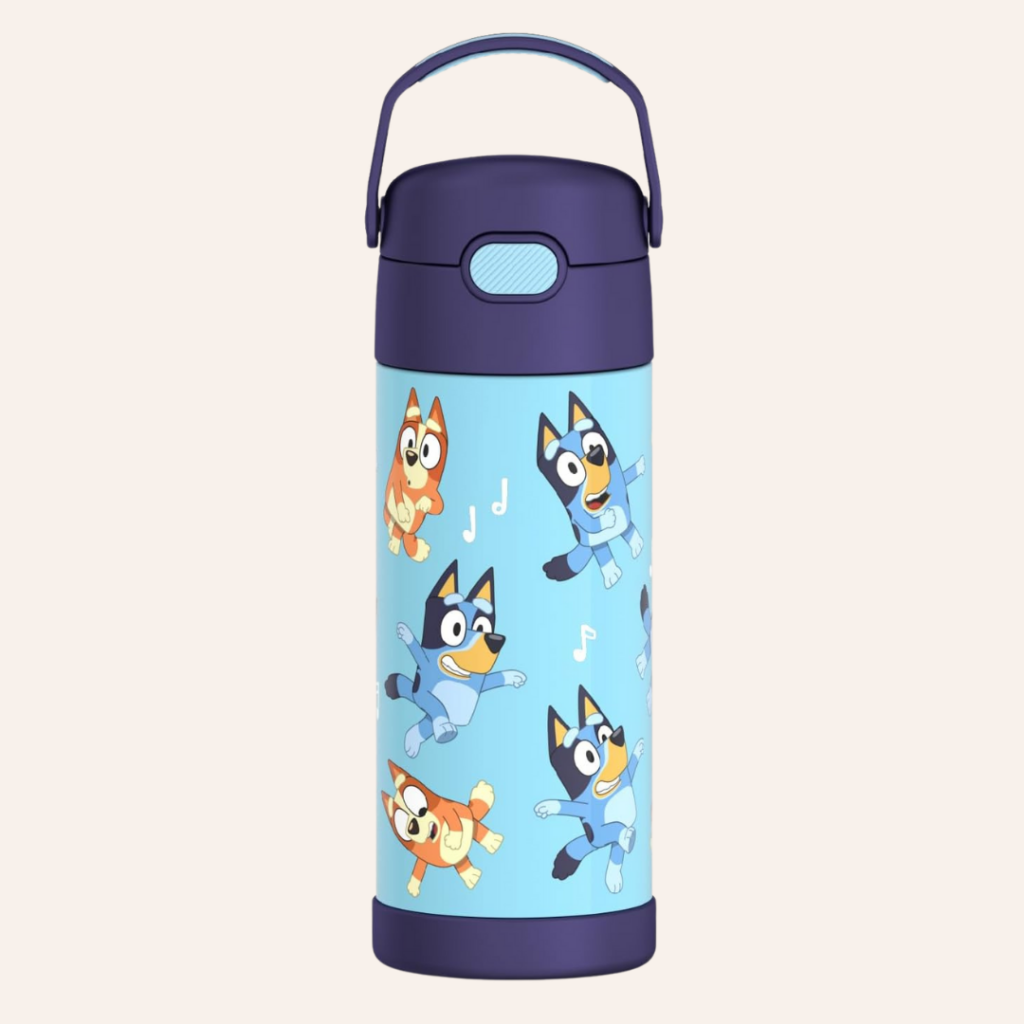
ELK AND FRIENDS STAINLESS STEEL DRINKING TUMBLERS + FOOD STORAGE
Versatile, fun, safe, and durable – Elk and Friends drinking tumblers are designed to minimize spills and messes, making them one of our top recommendations for toddlers!
Elk and Friends stainless steel tumblers also double as food storage – pretty cool right? When using the food storage cover the cups are completely leakproof, making them a great option if you want to pack a beverage for later. They work perfectly for smoothies as well as water!
Again, these have no measurements and the smallest stainless steel option can hold up to 10 oz. meaning you have to be careful about how much is offered to babies under 12 months of age.
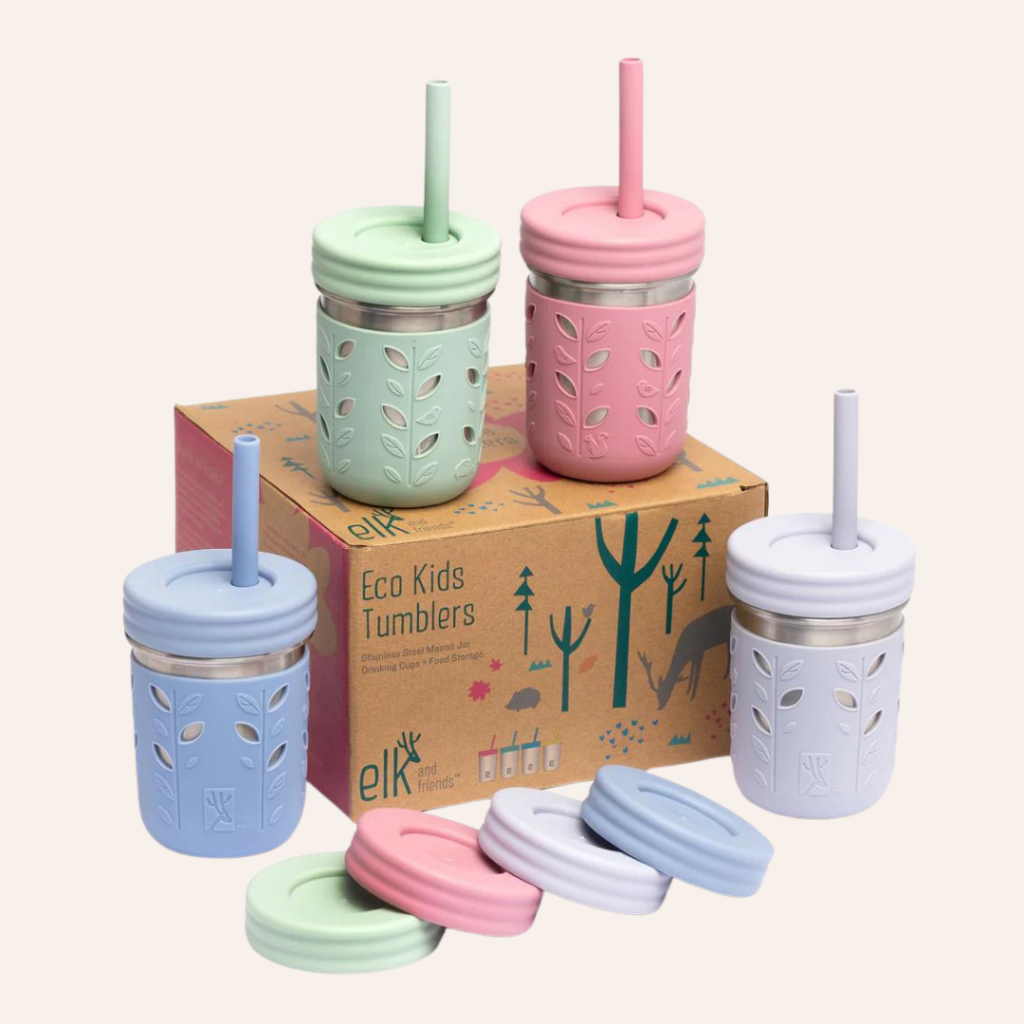
Tips for getting your baby to drink water
Every baby is different, so while some may love drinking water from the very beginning, others might need a bit more encouragement!
There are a few things you can do to help encourage your baby or toddler to drink water, including:
- Picking a fun water bottle
- Adding novelty with ice cubes and fun straws
- Adding fresh fruit for flavoring
- Modelling drinking water for them
- Prompting your toddler to drink from a water bottle every half-hour
If you want more details about all of these tips, you can read more in our blog on hydration tips for toddlers.
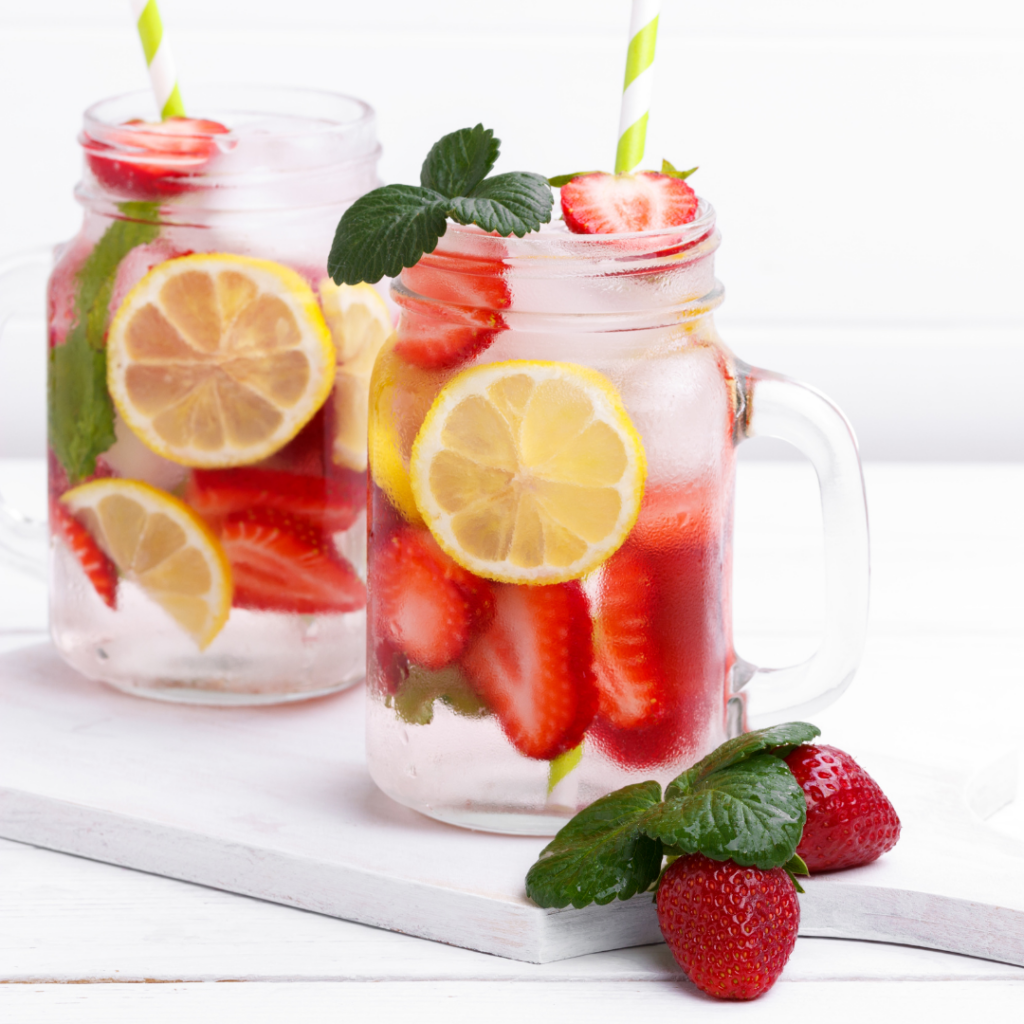
Note: One thing to keep in mind is that if you use ice cubes, fun straws, or fresh fruit to entice your baby or toddler to drink water, they can very quickly begin to expect that as the new norm. Be sure to switch things up and try each of the tips above to keep your baby or toddler guessing. This will still encourage water drinking without having them become reliant on the “special” water every time.
Trust us, it can get old fast! Unless you can guarantee you’ll always have fresh fruit or a fun straw on hand to make water interesting (consider times when you might have to buy a bottle while out of the house), getting them used to plain water is important too.
Water for babies FAQs
My baby is obsessed with water, what do I do?
Some babies really LOVE water. Which is great…once they’ve celebrated their first birthday!
If your baby is under 12 months of age, you’ll want to monitor the amount of water they consume throughout the day. If it’s more than 4 oz between the ages of 6-9 months or more than 8 oz between the ages of 9-12 months, it’s too much. As mentioned above, too much water can lead to water intoxication.
To keep them from going overboard, only offer 1-2oz of water at a time. If they’ve had their max for the day, you can offer a sip of breast milk or formula in an open cup after they’ve finished their solid food meal. This is just for the purposes of practice and to wash down any food trapped in their mouth.
My baby only bites on the straw, and won’t drink the water, what do I do?
This is very common – so no need to worry! Usually, when something is in our mouth, it’s meant to be bitten or chewed (like food). So we have to teach your baby that a straw is for drinking, not for biting (using a shorter straw sometimes does the trick)! Generally speaking, babies just need more time and practice with drinking from a straw to get the hang of it.
The easiest way you can help your baby learn to drink from a straw is to take a straw and use your finger to trap a bit of water in the bottom. Hold the straw up to your baby’s lips and wait for them to wrap their lips around the straw before you release the water by moving your finger. Over time, this helps your baby learn that closing their lips around the straw = liquid coming out.
Biting on straws could also be related to teething if your baby has sore gums. You can offer teethers throughout the day to help with the pain.
Can my baby have sparkling water?
We don’t recommend offering sparkling water to your baby as it can cause gas and bloating. Sparkling water may also contain added sodium, which we recommend avoiding for babies. At the end of the day, a small sip of sparkling water here and there won’t be harmful to your baby, but do your best to limit or avoid it if you can.
Can my baby have fruit juice mixed with water?
We do not recommend mixing fruit juice with water. In fact, we recommend avoiding all fruit juices and sweetened drinks for babies until at least 1-2 years of age due to the amount of added sugar found in most fruit juices.
There are some exceptions to this, such as offering diluted fruit juices (in a cup only, not in a bottle) as a way to help with constipation. However, this should only be done as directed by a medical professional and under their supervision.
Does my baby need extra hydration if they’re sick?
Since your little one’s appetite may be down and the risk for dehydration through fever or diarrhea may be up, focusing on hydration when they’re sick is very important.
For babies under 1 year of age, the best thing to do is offer breast milk or formula frequently, especially if they’ve refused solid food meals. Keep offering those meals if they’ve started solids, but let milk take over for hydration since they may not get enough if you’re too focused on solids.
For toddlers over 1 year of age, you can offer additional beverages to help keep them hydrated while they’re sick. You can also offer hydrating foods at meal and snack times. Take a look at our blog on feeding your baby while they’re sick for a list of beverages and hydrating foods you can try.
Can water help with constipation?
Yes! Water can be helpful for babies suffering from constipation, if your baby is over 6 months. You can offer sips of water up to a maximum of 3 oz/day for babies 6-7 months of age, 4 oz/day for babies 8-9 months of age, and 8 oz/day for babies 9-12 months of age.
You may also want to consider offering high-fiber foods for your baby to help relieve constipation. This would include foods like prunes, pears, plums, beans, lentils, chickpeas, chia, flax, wheat germs, berries, avocado, ripe bananas, sweet potatoes, beets, broccoli, and carrots!
To find all the in-depth, research-backed info for starting solids in one place, and get over 60 recipes that include the strategic introduction of top allergens, weekly grocery lists, and that advance through our signature Texture Timeline™, get our baby led feeding course + meal plan bundle today!
Learn all about introducing solid foods the way that you and your baby want to start. Just follow the plan, step-by-step, and gradually introduce foods at a pace that works for you, with our expert guidance along the way.
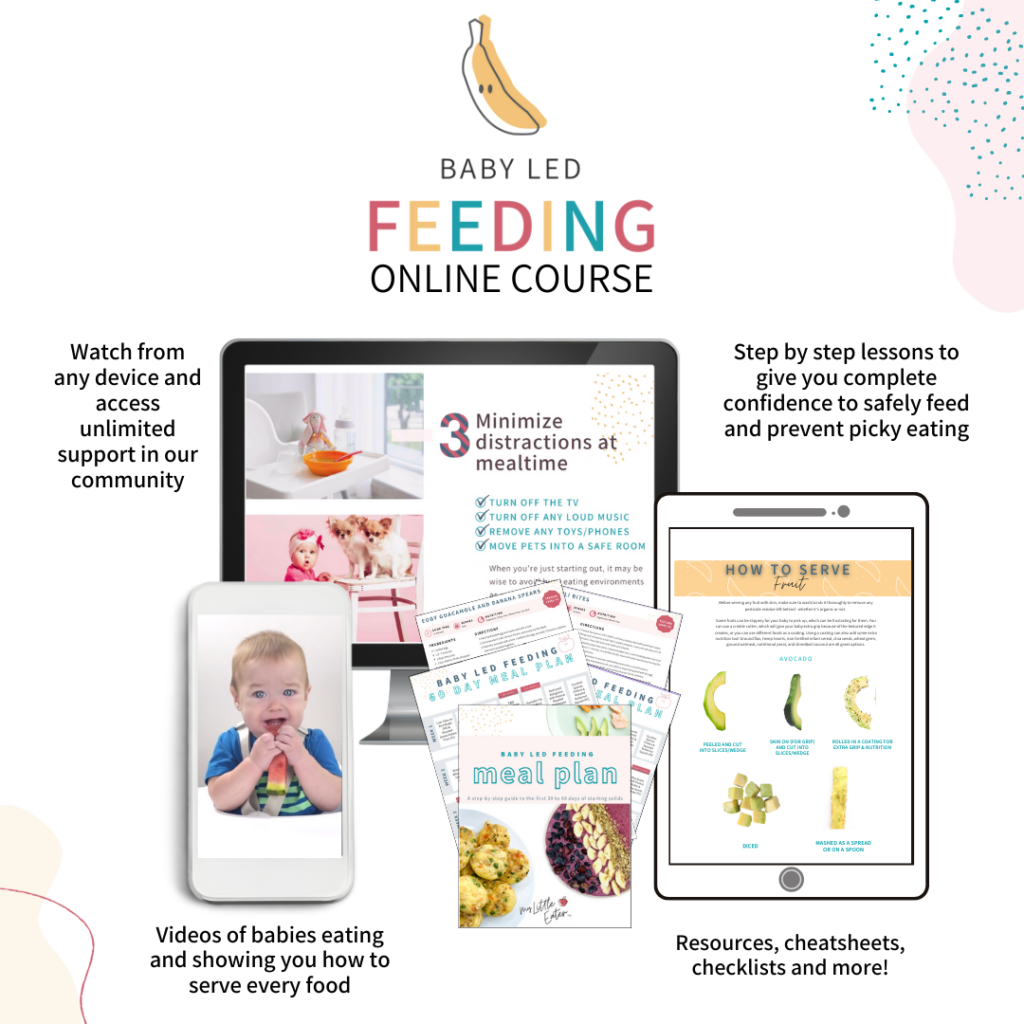
LOVE IT? PIN IT TO SAVE FOR LATER!
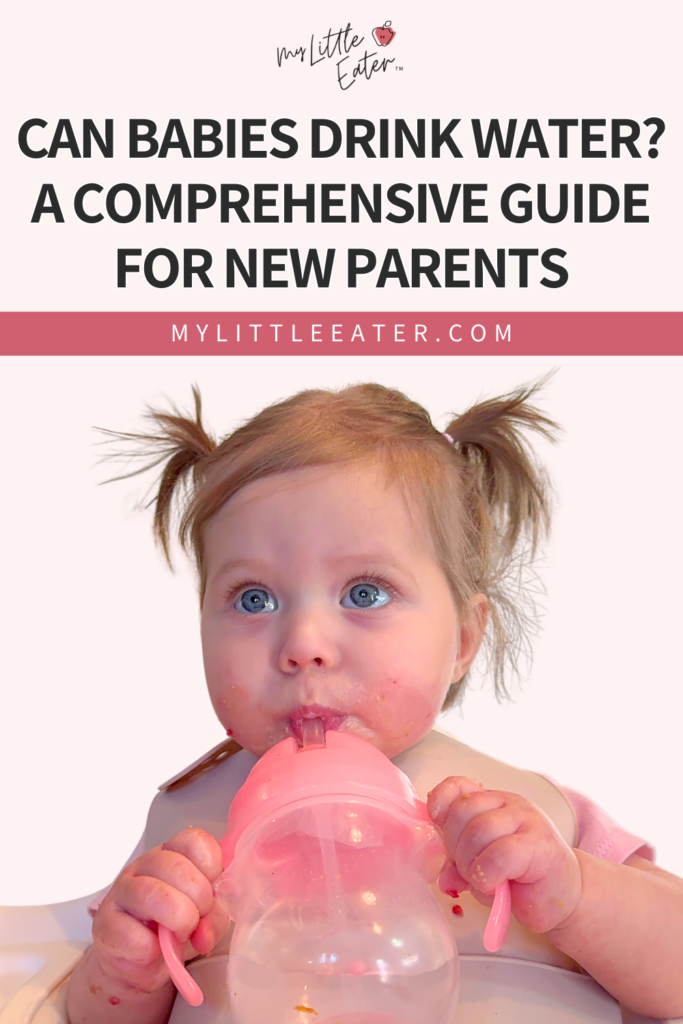
References
- American Academy of Pediatrics. Recommended Drinks for Children Age 5 & Younger, 2023. Retrieved from https://www.healthychildren.org/English/healthy-living/nutrition/Pages/Recommended-Drinks-for-Young-Children-Ages-0-5.aspx
- Suzan, Ö. K., Kaya, Ö., Kolukısa, T., Koyuncu, O., Tecik, S., & Çınar, N. Water consumption in 0-6-month-old healthy infants and effective factors: A systematic review. Biomédica, 43(2), 181-199, 2023.
- Encyclopedia of Children’s Health.Overhydration, 2021. Retrieved from http://www.healthofchildren.com/N-O/Overhydration.html#ixzz6dqMdRw4t
- Lingampalli, N. Water Intoxication. Berkeley Scientific Journal, 2013. Retrieved from https://escholarship.org/content/qt438611v2/qt438611v2.pdf
- American Academy of Pediatrics. Signs of Dehydration in Infants & Children, 2019. Retrieved from https://www.healthychildren.org/English/health-issues/injuries-emergencies/Pages/dehydration.aspx
- American Academy of Pediatrics. How to Safely Prepare Baby Formula With Water, 2024. Retrieved from https://www.healthychildren.org/English/ages-stages/baby/formula-feeding/Pages/how-to-safely-prepare-formula-with-water.aspx

Chelsey Landry, RD
Community Dietitian at My Little Eater Inc., and bunny-mom to Hickory. Chelsey offers one-on-one counselling to parents of babies and toddlers that need more customized support. Learn more by booking a free discovery call with her today!

Chelsey Landry, RD
Community Dietitian at My Little Eater Inc., and bunny-mom to Hickory. Chelsey offers one-on-one counselling to parents of babies and toddlers that need more customized support. Learn more by booking a free discovery call with her today!
